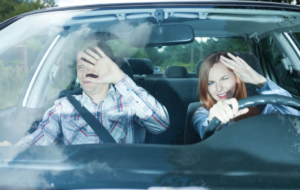Why Driving On High Beam Is Probhited? Hey, folks! There is no doubt that driving at night presents unique challenges, with reduced visibility being a major concern. To overcome this, vehicles are equipped with headlights that provide different illumination settings, including high beams and low beams. While high beams offer enhanced visibility, they are prohibited in certain situations due to the potential hazards they pose on the road. So, if you also want to know why it is prohibited to drive with high beams and how their misuse can lead to accidents.
Well, being on the highway comes with many responsibilities and it is not only you are driving and your responsibility to reach your home safely, but it also includes that you ought not to show off on the roads and risk others’ lives. Also, as you all know that highways are crossing such areas where animals can be found, and it is also a main reason why many things such as blowing horns, changing lanes, driving on high beams, etc are prohibited on the highway. However, some people still don’t follow instructions and drive on high beams which comes out to be a major reason for accidents on highways.
Why You Should Not Drive With High Beams?
Driving on high beams can be potentially dangerous and should be avoided in most situations. High beams are designed to provide maximum illumination and visibility in dark or poorly lit areas, but they can be blinding to other drivers, especially when approaching from the opposite direction. The intense brightness can impair their vision, making it difficult for them to see the road clearly and increasing the risk of accidents.
Additionally, using high beams in urban areas or well-lit roads can be highly distracting and uncomfortable for other drivers, pedestrians, and cyclists. It is important to use low beams when driving in normal conditions and only switches to high beams when necessary, such as on unlit rural roads or when there is no oncoming traffic, to ensure the safety and well-being of everyone on the road.

What Is The Role Of High Beams?
So, basically high beams also known as main beams or full beams, are designed to provide maximum illumination and extend the range of visibility for drivers. They emit a powerful light beam that helps illuminate the road ahead, making it easier to spot potential obstacles, pedestrians, and animals. However, the intensity of high beams can create problems if used irresponsibly.
Despite the fact that they are important, they are prohibited not all the time but in certain situations for the safety of all road users. In urban areas or well-lit roads, the excessive brightness of high beams can cause discomfort, glare, and temporary blindness for oncoming drivers. This can result in impaired vision, reduced reaction time, and an increased risk of accidents.
Risks of High Beam Misuse
- Glare: The intense light from high beams can cause glare for drivers approaching from the opposite direction or those traveling in front. Glare can impair their vision, making it difficult to perceive the road and potential hazards accurately.
- Reduced Visibility: When high beams are used in foggy or rainy conditions, the light reflects off water particles and creates a blinding effect, reducing visibility for the driver. This can make it challenging to judge distances and react to sudden changes on the road.
- Distraction: High beams can also distract other drivers on the road, as the bright light can draw their attention away from the road ahead. This distraction can lead to delayed reactions and an increased risk of collisions.
Can High Beams Cause Accidents?
Well, to this question the simple answer is, Yes, the misuse of high beams can lead to several incidents where the main one is, it can directly impact the eyes of the driver who is driving in the opposite direction to you by blinding that driver. The misuse of high beams has been a contributing factor in numerous accidents. Some common scenarios include
- Head-On Collisions: When drivers fail to dim their high beams when approaching another vehicle, it can lead to head-on collisions due to poor vision and reduced reaction time.
- Pedestrian Risks: High beams can blind pedestrians, making it difficult for them to see oncoming traffic and judge the distance of approaching vehicles. This can result in accidents and potential harm to pedestrians.
- Road Rage and Aggressive Behavior: Extreme use of high beams, especially when tailgating or flashing them at other drivers, can lead to road rage incidents and aggressive driving behavior. This can escalate the risk of accidents and harm to all involved.
Importance Of Low Beam Usage On Highways
Well, as we are talking about the lighting range in the cars then how can we forget the first level of lighting? So, you must have seen people driving with low beams at night. Well, you must be thinking why do they drive with low beams, well, there are specific reasons to drive with low light, especially on highways. Here are some main reasons that make it more important.
- Enhanced Visibility: Low beams provide adequate lighting for the driver to see the road without causing glare or discomfort to other road users.
- Reduced Blind Spots: Low beams ensure a wider field of vision for the driver, enabling them to detect potential hazards, such as pedestrians or animals, on the sides of the road.
- Respect for Fellow Drivers: Driving with low beams on highways indicates a consideration for other drivers, reducing the risk of accidents caused by impaired vision or distractions.
Heading to the end of this article, finally, we can say that driving with high beams can be tempting due to the increased visibility they offer, but their misuse can have severe consequences. Glare, reduced visibility, distraction, and accidents are all potential hazards associated with driving on high beams. To ensure the safety of all road users, it is essential to adhere to traffic regulations and drive with low beams at night, especially on highways. By doing so, we can collectively contribute to safer road conditions and reduce the likelihood of accidents caused by high beam misuse.






GIPHY App Key not set. Please check settings